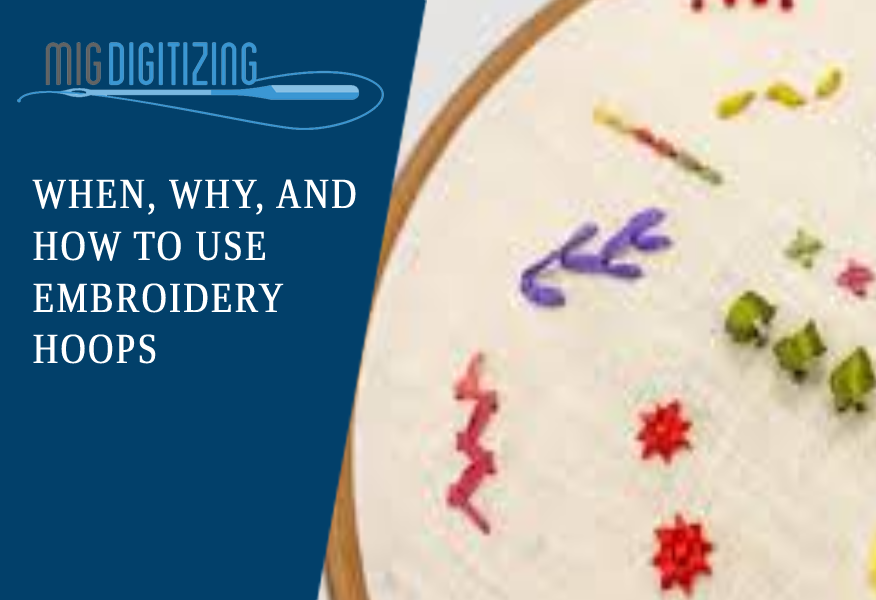
Anyone who performs cross stitch or hand stitching is aware of embroidery hoops, but there is a lot to learn about them. This post will teach you all you need to know about embroidery hoops, including the many types, how to choose the proper one, and how (and when) to use them. To discover everything there is to know about embroidery hoops, keep reading. Are you looking to expand your hoop collection?
The type of stitching you're doing, the fabric you're using, and your degree of experience all contribute into whether or not you should use an embroidery hoop. Having your fabric kept taut in an embroidery hoop can be especially useful when doing hand stitching. Tension aids in the creation of neater stitches. It can help keep the areas between stitches from puckering. Some types of hand embroidery, such as sashiko, don't require the use of a hoop.
A hoop isn't as important for cross stitch as it is for hand stitching, but it can help you make more even stitches. Fabric selection is also important. When cross stitching on linen, we use a hoop more than when working with Aida since having the fabric taut lets me see the finer weave of linen better. When cross stitching on dark fabric or with speciality threads, a hoop can be quite handy.
When it comes down to it, you have the option of using an embroidered hoop or not. Some embroidery digitizers use hoops all the time, while others only use them sometimes. They all hold cloth in essentially the same way: sandwiched between an inner and outer ring. The way tension is formed on the fabric is the fundamental variation between the sorts.
Screw Tension
The most frequent type of embroidery hoop is this one. The hoop's tension can be adjusted with a screw on the outer ring. Screw tension hoops are widely accessible and come in a variety of materials, sizes, and shapes.
Tension in the spring
A metal inner ring slots into a grove in the plastic outer ring to create tension in these hoops. Spring tension hoops are commonly used for machine embroidery, but they can also be used for hand embroidery and cross stitch. The handles are big and might get in the way, but they keep the cloth nice and snug.
Flexi Hoops - Hoops that bend
Flexi hoops like real wood, but they're actually composed of a flexible vinyl that wraps around an inner plastic ring. They are really effective at holding the fabric in place, although they can be difficult to use. Rather than utilising them while stitching, we prefer to use them to frame a finished piece.
Wood vs. plastic
Plastic is a low-cost material that can be a suitable option for novices. Molded edges on some plastic hoops help keep fabric particularly tight. Always look for high-quality plastic hoops. Plastic hoops can twist and bend if the material isn't strong enough.
Wood hoops, like plastic hoops, come in a number of sizes. They also come in a variety of widths, ranging from narrow to thick, so you can find one that fits your hand just. Varying fabric weights are accommodated by the different widths: narrower hoops for thinner fabric, thicker hoops for thicker fabric.
Look for a wood hoop with smooth, round edges that don't splinter or snag when selecting one. Look for brass fittings that are of good quality as well. These beechwood hoops from Hardwicke Manor are our favourites. They're silky smooth, sturdy, and delightful to grasp. Be wary of the low-cost wood hoops available at most big-box craft stores. They often have splintering rough edges. They also gape and warp, and the fabric isn't well held. Avoid them to save yourself the trouble.
Hoop design
The most popular shape for embroidery hoops is round, but oval and square shapes are also available. Round hoops come in a wide range of sizes, but oval and square hoops have fewer options. When stitching a square design, a square hoop isn't required, although it can be useful if you wish to fit the full design into the hoop.
What size hoop should I use?
Hoops come in a variety of diameters, ranging from 3 inches in diameter to 12 inches or more in diameter. (Quilting hoops, for example, can be significantly bigger.) Larger hoops are typically more difficult to grasp while stitching. We usually choose hoops that are between 5 and 8 inches in diameter.
Choose a hoop that is approximately one inch larger than the design you are stitching. Because holding a hoop larger than 8 inches can be awkward, it's fine to recenter the fabric in the hoop as needed for larger items; just remember to remove the fabric from the hoop when you're not sewing. The procedure of inserting your cloth in a hoop, regardless of style, is roughly the same.



